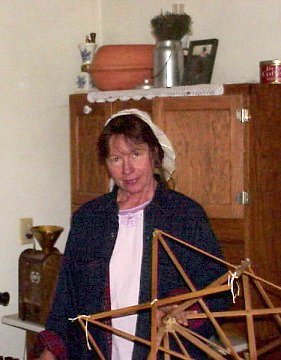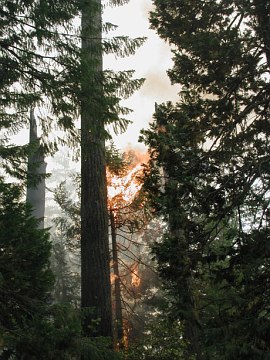~~* Black Sheep Newsletter............Issue 113............Autumn 2002 *~~
 †
†
THE HOMESTEAD: Oregon Fires
Pneumonia in Goats
I've had a good old-fashioned case of "writer's block" the past few days. When I should have been thinking hard about another column for this good magazine, I found myself instead busy with the task of shepherding, and even more than that – busy with the task of nursing. Until your farm has been "hit" hard with contagious pneumonia, you will not know what a harbinger of ill will it can be. Sudden death amongst the best of the flock – a string of deaths that leave a shepherd befuddled and undone, is usually the way it runs its course. Like a tornado, and yet secretive in its selection, it can pick out the very young of the flock or the ancient. It can even be as sly as to take your best goat in the prime of his/her life.![]()

Xandra
In the goat section of one of my favorite veterinary books, Veterinary Guide for Animal Owners, by C. E. Spaulding, DVM, he describes contagious pneumonia as follows: "Pneumonia or a pneumonia complex is, in my opinion, the greatest cause of death and financial loss in goats. Not only do they die from pneumonia, but also when they are left living they are miserable and useless as far as milk or meat production goes." My own note: I would say "as far as milk, meat or fiber production goes."![]()
He goes on to list possible causes of the dreaded disease. I will skip over a few here and come to: "Changes in Weather: Sudden severe cold snaps, rain with bad wind, hot muggy summer days or hot days followed by icy nights are all stresses."![]()
Well, as a matter of fact – those exact weather conditions had been occurring for the last two or so weeks at our farm. The daytime temperatures continued to plod well past the 90 degree F mark. The air was either filled with the dry winds we have been receiving all summer long, or were dreadfully still – the hot mugginess stifling. The herd of goats did not want to leave the shelter of the barn, though I tried to prod them outside – just so that they could walk around the pasture and nibble at whatever was still green (which was not much.) They had their fill of the best alfalfa in the world earlier – and that seemed to suffice. No one wanted to leave the barn.![]()
Meanwhile, the nighttime temperatures plummeted wildly, leaving their frosty signature a few times on our garden. Crisp nights descended upon us, chilling us to the marrow. In the mornings when the fog would lift, another hot dry windy day would usher forth. It gave me plenty to worry about.![]()
Having kept Angora goats for a few years, I soon learned that sudden and unexpected weather changes can cause havoc. Keeping an eye open for any problems, I still was not wary enough. It began with the youngest member of our herd – a little white goat born mid-June. I separated him from the rest of the herd, and for awhile he became our "pet" house goat. Though he was sick, he did not seem to have pneumonia – which gave me hope. I fed him so that he would become strong. Even so he remained weak. Though I kept him in the house at night, I allowed him outside in the heat of the day, but he lasted only about two weeks after the onset of his "going down." He never went off feed. The last night before I put him up in the back room he seemed content eating a small grain ration (rolled barley.) But he died in the night.![]()
A week ago we had our first big rain, after literally months of drought – a heavy pelting downpour that lasted a good hour and then diminished, leaving a coldish night in its wake (the stars were again lit in the heavens.) A wonderful buck in the prime of his life died some time that night. We found him stiff and cold in the morning.![]()
I didn't know whether he had contracted pneumonia days earlier and I did not take notice – or whether his death occurred in one fell swoop on that rainy night. After a death, my husband and I always try to autopsy our animals, so after the initial shock of finding him dead, we examined his internal organs. Everything looked good and right, but his lungs were not a pink healthy coloration. Indeed, they were very dark crimson, with patches of purple blotches. Pneumonia again.![]()
In his book, Dr. Spaulding calls pneumonia "the silent killer" of goats. He definitely advises taking a goat's temperature if that goat seems "off" in any way. The problem with pneumonia, however, is that so often the animals do not appear to be "off" in any way. They are still eating and drinking and walking about, acting perfectly normal. As Dr. Spaulding says:
"Most goats with pneumonia will run a high temperature. The average for pneumonia is 104 degrees F to 106 degrees F. If one goat has a high temperature, check the others. I've seen goats with pneumonia and a 107 degree F temperature look okay and be eating fine. Two had suddenly died the night before – no sign of illness, but their lungs were a mess. Bear in mind – a goat's temperature can normally vary according to the animal or the outside temperatures. A goat with a 102 degree F temperature would be sick with a 103 degree F temperature that would be normal for another goat. Know your goats' temperatures."![]()
All this is to say that we've had a hard couple of weeks here on the farm, with the sadness of losing one and then two of our barnyard family, each of whom is called by name and knows the voice of the shepherd who calls it out – while shaking a grain can.![]()
Note: If the above paragraphs help even one shepherd take extra precautions during those ever changing days when summer's heat turns overnight to autumn chill – and is able therefore to save but one of the flock (goat or lamb) – I will feel as though this quarter's column was well worth my effort. Though a couple of feisty calves with scours kicked two successive basal thermometers from my reaching and probing fingers years ago, I always made sure to purchase another – so that my veterinary supply box is never without one. However, the biggest problem remains that a sick goat is not always discovered until it is too late.![]()

Tiller Aflame
Oregon Fires
This summer was a record year for Oregon in the way of fires raging across our forested land. Indeed, the air where we live was barely breathable for all the smoke from the nearby fires that seemed for a long time to completely "surround" our homestead. Because of this, the fires may have seemed closer than they really were.![]()
It was not an easy task to look out into the distance and see the looming pillars of smoke billowing into the air, and not feel sudden fear – especially for the herd of goats that stood in the paddocks. The task of moving them seemed daunting and monumental. We hoped it would be totally unnecessary to have to move approximately 70 Angora goats (by trailer) to pastures belonging to friends and acquaintances of ours that continually emailed and called us daily offering any services they could render. Indeed, a friend of ours stopped by the place one afternoon with his horse trailer towing a horse.![]()
"If you need me to help move animals, please let me know! I'm moving horses right now from off the mountain." He was helping other friends with their needs.![]()
"I think we'll be fine," I answered our kind friend, matter-of-factly. He must have seen the fear in my eyes, however. Indeed, I started to feel as though people were sensing an urgency in the matter that I could not comprehend. Feeling a bit "Pollyanna" about it all – I maintained that all would be well in the end, and that we should just stay and wait it out.![]()
As it turns out, I was right. That's not to say that the whole situation was not frightful. The worst of it was that the fires burned for eight successive weeks.![]()
Stan and I managed to keep our equilibrium throughout the long ordeal. It was especially hard to find that the fires were growing daily – monumentally – consuming acres and acres of prime Oregon forestlands. The strong and courageous fire fighters that fought them were seemingly overcome at times and "under-staffed" at others, especially here at what was known as the Tiller Complex Fires. The winds howled daily and continued to fan the unquenchable flames that were feeding on the Oregon forests with an intensity that seemed nearly supernatural.![]()
But, after all, my life was that of a shepherd. Daily I monitored the goats that seemed to be suffering no ill effects from the continual smoke that filled the air. There were times I wondered what kind of stress factor smoke inhalation day in and day out would be for them, but my fears were mostly unfounded. In fact, someone wrote me and told me that the smoke was probably not sufficiently concentrated to cause problems for either humans or animals. Since she was a now retired RN, I took her word for it and stopped worrying for the health of the animals' lungs. Interestingly, it was the goats that I was concerned for – not so much myself.![]()
In the end we remained here and never had to evacuate like so many others in this fair state of ours. Though the vapor of smoke, gray and foreboding, rarely gave way to blue skies during a nearly two month siege, we were able to continue with our lives mostly unaffected - this despite the helicopters that flew overhead, spotter planes whose engine drones became comforting to hear, and the truckloads and busloads of men and women firefighters who traveled the wide road in front of our home on their way to another fire.![]()
Indeed, my daily stroll with the goats up mountainsides and low into shady creek bottoms continued in spite of the land's thirst. Most of the creek bottoms were dry ravines by then – round river rock that still held small pools of cool water in July, but were totally dry by the time the hot month of August arrived on the scene.![]()
I wrote last year of our Oregon drought, as some of you may recall. Though I fretted to you of its difficulty, in retrospect last year was a piece of cake in comparison to what we went through this summer. This year was the year of the fires.![]()
I am happy to write that the fires are finally fully contained. Our own Tiller Complex fires devoured 70,000+ acres of forestland. Additionally, the infamous Florence/Biscuit fire, the huge consuming fire some nicknamed "The Beast," was the biggest fire this state had ever seen.![]()
It is the courageous men and women who hailed from every state in this great nation and even from other parts of the world – Australian and Canadian firefighters – working diligently alongside Oregon, Montana and Idaho firefighters – who were truly the heroes. Their ready willingness to fight fire, risking their very lives, paid off. If just one of those brave souls is reading this column – I wish them to know that all the "Thank you, firefighters!" signs they witnessed hanging from the siding of our homes, taped up to store windows and stapled to fence rails were heartfelt. Here in Tiller, Oregon, many of us lived a bit on edge as our forests burned up. It is as though I cannot say it enough times. Thank you, firefighters! This summer will be a memory that stays with me forever.![]()
Laughter is Surely One Heck of a Medicine
So as not to make this entire column one of apparent gloom and doom, I think I'll close with a precious tidbit sent to me from a dear friend and fellow Angora goat lover, spinner of mohair and fiber artist. It's a true story – not something she made up – which gives it all the more charm. Here's her email in its entirety. Thank you, JoAnne, for making my day that dreadfully hot and windy August 14th that you wrote. With your permission, I have passed it on herewith:
My dad sent me the following ad found on the bulletin board at the feed store in Sturgis, South Dakota.
"100 Angora Goats, had for 5 years. Ate weeds on Section of Ground, even poison ivy. Made $3000 year on mole hair. Also smart Heard Dog and 2 male llamas. Come see. XXX-XXXX." (Actual spelling in advertisement.)
Originally, my dad thought I might be interested in the Angora goats, which is why he sent me the ad, but after careful consideration, I decided to save my money. I figured the reason the guy was selling his goats in the first place, was because he was making so much money on the mole hair. $3000/a year is a really good return when you don't have to pay for any feed.
I'm always on the lookout for "groundbreaking" ideas, and I really think this is it. I already have a small herd of moles digging in my front yard, so I could encourage them to breed, catch the little critters, shear them, and turn them loose to fend for themselves until it was time to shear again. You could even start a mole recovery business, catch them in other people's yards and bring them home. If your yard got too small for the large herd, well, they could just tunnel into the neighbors and no one would be the wiser.
I wouldn't need to purchase his "heard dog" since our dog is already good at listening for moles. He stands at the holes when he finds one, perks up his ears and tilts his head back and forth and I know he hears them. Even better, he loves to dig them up. I've always discouraged him of that because of the holes he makes, but if I get into this business, his help will be sorely needed come shearing time.
So my question to you is how is mole hair for spinning? Also, since I plan on a large herd of moles, do you know of a local buyer, or will I have to find a mole hair buyer in Texas?
JoAnne
PS I have yet to figure out why he kept the llamas."
In Conclusion
Have a good breeding season, Angora goat enthusiasts and sheep farmers. By the time this is in print – you will have some very pregnant does and ewes. Our eight sheep were bred in early September, when the chill air arrived in the evening hours and the mornings turned colder. Now we wait with bated breath as the bucks stationed in their own corrals eye the fences with great disdain, and the does on the other side of those fences prepare their lipstick and powder puffs.![]()
Yesterday, for sure, I began to feel a certain dread that I was "too late" with separating our bucks from our does this season. Having a hundred pressing matters on the farm, Stan and I had left all the bucks with the does a bit later than usual. On the way back from browsing in still brown fields, I saw that the bigger bucks were quite enamored by a flagging goat in their midst. Panic set in. I did not want to bred that one white doe to Zebulun, the biggest of the bucks whose retirement I well believed had come.![]()
"No, Zeb – no!" I pushed my way gallantly between his snorting frame and the smaller white animal who was sprawled on all fours – flattened to the ground – because each time he tried to mount "her" – she would not stand for him. Yet her tail furiously signaled all the bucks around that she was in ready heat.![]()

Willow in holding
In time I was able to take a hold of the big buck's horns and push him inside the gate. Then I pushed away the smaller bucks who were all attempting to gain the white goat's attention. Finally I was able to pick "her" up. Indeed, strangely enough, she surely resembled a wether (castrated male) we had named Arnald. One quick hand to the scrotal area of the goat (as I held the goat up in my arms) confirmed that this was indeed Arnald.![]()
I still don't know what wires were crossed in that brain of his. But when all was finally settled and all the bucks were stationed on one side of the fence, the does all on the other – Arnald stood in the doe pen. He continued to walk alongside the fence, pressing his elegant body against the wire, his tail magnanimously flagging – the perpetual signal to bucks everywhere that a doe is in heat. I figure by the time the does do come into estrus, Arnald will have figured out what sex he is – and I can effectively move him to the buck pen.![]()
It's hard to keep a good goat farmer down, after all. So we shake the dust from off our trouser knees, right ourselves and press forward, grain can in hand.![]()
A good autumn to you, fellow shepherds and fiber enthusiasts.![]()
Alexandra Scribe
Homestead Home
TOP






